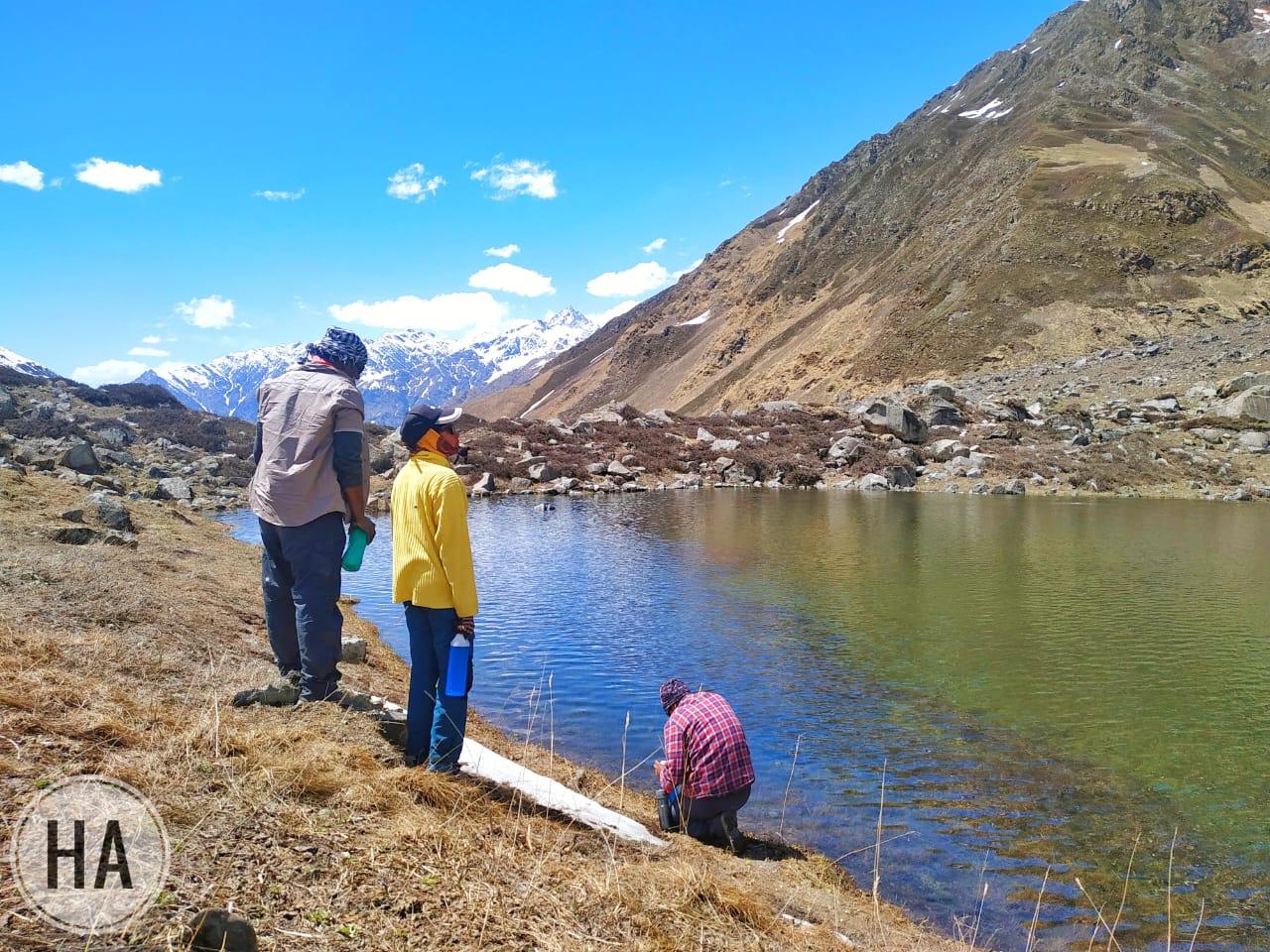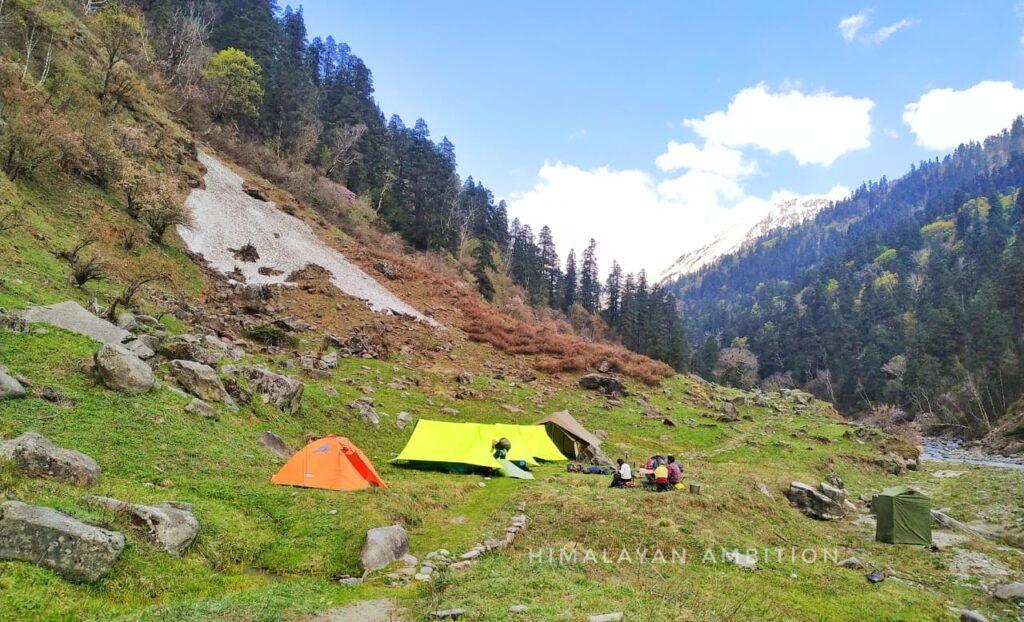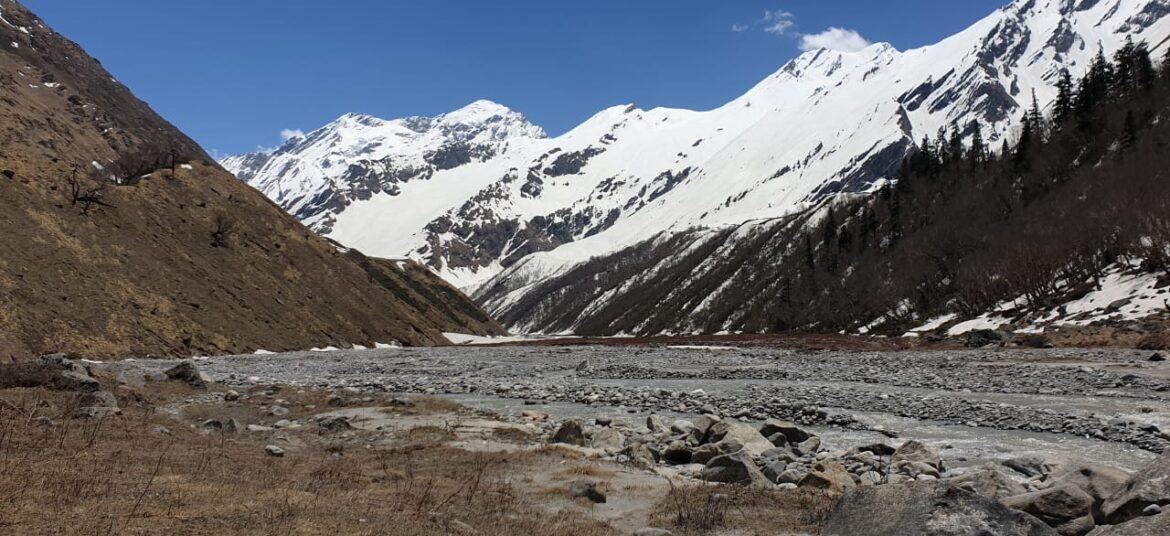
ruinsara Lake
+5% GST
₹ 11500

Stay

Taxi

Meals

Guide

Camping
Garhwal Himalayas
7 days
Easy To Moderate
48 km
Mar-Jun & Sep-Nov
12000 ft.

Ruinsara Lake
+5% GST
₹ 11500

Stay

Taxi

Meals

Guide

Camping
Garhwal Himalayas
7 days
Easy To Moderate
48 km
Mar-Jun & Sep-Nov
12000 ft.
About Ruinsara Lake
- Region : Uttarakhand
- Duration : 7 days
- Base Camp : Sankari
- Pickup/Drop Point : Dehradun Railway Station or ISBT Bus Stand
Ruinsara Lake

If you are looking for the most beautiful trek through the Govind National Park, then Ruinsara Lake trek is the best option. The Govind National Park is known around the globe for its wild flowers especially orchids.Ruinsara Tal is a sacred lake that is present close to the source of the Supin River. This area is well-known for having some of the most gorgeous forests around the globe. The surrounding mountaintops and glaciers in the Banderpoonch range are definitely a delight for mountaineers. It is important to know that Ruinsara lake trek is popular for its wild flowers and grazing paddocks which are used by local shepherds. Located in Uttarkashi district at an altitude of 11,500 ft., Ruinsara Lake is at the base of the Black peak. During the trek, you will come across green grasslands, rhododendrons, and alpine vegetation, offering you a delightful feeling and refreshing your soul.

Ruinsara lake is related to Hindu Mythology and villagers here say that Pandavas opted this route for their surmounting to heaven through Swargarohini. Pandavas even roamed in the forests during their exile period. While trekking, you will notice that Ruinsara lake is beautifully surrounded by tall standing summits like black peak, Bandarpoonch, Swargarohini, and Ruinsara range, offering you breathtaking views of nature. You need to know that Ruinsara Tal trek is the most gorgeous lake in Uttarakhand Himalayas. Remember the path from Devsu Bugyal to Ruinsara Tal, is a bit complicated one. The Ruinsara Tal is a special glacial lake that rests amongst the gorgeous mountain ranges of Swargarohini peak. The paddocks here are beautiful, neat, and untouched at the same time. All the trekkers can experience a sense of calmness around the lakeside. While trekking deep into the adored valleys of Garhwal, you will be stunned by the delicate beauty of Ruinsara Tal which is stuck at almost 3,500 meters above sea level. Remember Ruinsara lake trek is pure bliss for adventure lovers and trekkers. The Ruinsara Tal is said to be holy by the residents of Har Ki Doon valley because it is surrounded by rosy red rhododendrons and alpine vegetation. As it is located below the Bandarpoonch glacier, the lake is considered an ideal camping location for trekkers. Along with this, there are also several interesting myths associated with this place. While trekking, you will go through some of the stunning and simple Himalayan villages with wooden houses and temples in which Pandavas worshipped their gods and goddesses. This trail is known for following the Tons river from Netwar township up through the lovely villages of Gangad, Seema as well as Osla. Remember the old temples at Pawani, Osla have enthralling Himachali architecture that can keep you absorbed with its untouched beauty for a long time. Trekkers who love high altitude pass traverses will definitely find themselves completely at home while trekking. So, if you wish to experience the life of remote villages of Garhwal Himalayas and enjoy scenic beauty then plan for a Ruinsara lake trek
FIX DEPARTURE
1st, 2nd, 3rd, 4th, 5th, 6th, 7th, 8th, 9th, 10th, 11th, 12th, 13th, 14th, 15th, 16th, 17th, 18th, 19th, 20th, 21st, 22nd, 23rd, 24th, 25th, 26th, 27th, 28th, 29th, 30th, 31st March.
1st, 2nd, 3rd, 4th, 5th, 6th, 7th, 8th, 9th, 10th, 11th, 12th, 13th, 14th, 15th, 16th, 17th, 18th, 19th, 20th, 21st, 22nd, 23rd, 24th, 25th, 26th, 27th, 28th, 29th, 30th, April.
1st, 2nd, 3rd, 4th, 5th, 6th, 7th, 8th, 9th, 10th, 11th, 12th, 13th, 14th, 15th, 16th, 17th, 18th, 19th, 20th, 21st, 22nd, 23rd, 24th, 25th, 26th, 27th, 28th, 29th, 30th, 31st May.
1st, 2nd, 3rd, 4th, 5th, 6th, 7th, 8th, 9th, 10th, 11th, 12th, 13th, 14th, 15th, 16th, 17th, 18th, 19th, 20th, 21st, 22nd, 23rd, 24th, 25th, 26th, 27th, 28th, 29th, 30th June.
1st, 2nd, 3rd, 4th, 5th, 6th, 7th, 8th, 9th, 10th, 11th, 12th, 13th, 14th, 15th, 16th, 17th, 18th, 19th, 20th, 21st, 22nd, 23rd, 24th, 25th, 26th, 27th, 28th, 29th, 30th Sep.
1st, 2nd, 3rd, 4th, 5th, 6th, 7th, 8th, 9th, 10th, 11th, 12th, 13th, 14th, 15th, 16th, 17th, 18th, 19th, 20th, 21st, 22nd, 23rd, 24th, 25th, 26th, 27th, 28th, 29th, 30th, 31st Oct.
1st, 2nd, 3rd, 4th, 5th, 6th, 7th, 8th, 9th, 10th, 11th, 12th, 13th, 14th, 15th, 16th, 17th, 18th, 19th, 20th, 21st, 22nd, 23rd, 24th, 25th, 26th, 27th, 28th, 29th, 30th Nov.
FAQs
The best time for the Ruinsara Lake Trek is typically from April to Mid July and September to October. During these months, the weather is generally favorable with clear skies and moderate temperatures, offering ideal conditions for trekking.
The Ruinsara Lake Trek is considered to be a moderate trek. While it does not involve technical climbing, trekkers should be prepared for long walks, varying terrain, and altitude gains. Good physical fitness and prior trekking experience are recommended.
The trek to Ruinsara Lake usually starts from a village called Sankri, located in the Uttarkashi district of Uttarakhand, India. Sankri serves as the base camp for the trek and is accessible by road from Dehradun, the capital city of Uttarakhand.
The duration of the Ruinsara Lake Trek typically ranges from 7 to 8 days, depending on the itinerary chosen by the trekking group. This includes trekking days, acclimatization days, and rest days.
Yes, permits are required for the Ruinsara Lake Trek, as it falls within the Govind National Park. Trekkers need to obtain permits from the Forest Department or authorized agencies before commencing the trek.
While it's not mandatory to hire a guide, it's highly recommended, especially for those unfamiliar with the terrain or inexperienced in high-altitude trekking. A guide can provide valuable assistance, navigation, and insights into the local culture and flora/fauna.
Accommodation options during the trek typically include camping in tents or staying in basic homestay available in villages along the route. Trekkers need to carry their own camping gear or arrange for it through trekking agencies.
Medical facilities are limited along the trekking route to Ruinsara Lake. Trekkers are advised to carry their own first aid kit, essential medications, and any personal medical supplies. In case of emergencies, evacuation can be arranged to nearby towns with better medical facilities.
Essential items to pack for the Ruinsara Lake Trek include trekking gear, warm clothing, hiking shoes, rain gear, sunscreen, insect repellent, a water bottle, snacks, a headlamp, a camera, and personal toiletries. It's important to pack light yet adequately for the journey.
While trekking solo is possible, it's generally safer to trek with a group or at least with a guide, particularly in remote and high-altitude regions like the Ruinsara Lake area. Trekking solo requires thorough preparation, navigation skills, and awareness of potential risks.
The Ruinsara Lake Trek can be challenging for children and elderly individuals due to its moderate difficulty level and altitude gain. It's advisable for children to be at least 10 years old and for elderly individuals to consult with a healthcare professional before attempting the trek.
Yes, the Ruinsara Lake Trek offers opportunities to interact with local communities and experience their culture firsthand. Trekkers can visit remote villages, interact with villagers, observe traditional practices, and learn about the local way of life.
Yes, the Ruinsara Lake Trek can be combined with other treks or activities in the region, such as the Har Ki Dun Trek, Devsu Bugyal or exploration of nearby valleys like Borasu region. Additionally, adventure enthusiasts can indulge in activities like birdwatching, photography, or nature walks.
The Ruinsara Lake area is home to diverse wildlife, including Himalayan birds like the Himalayan Monal and Golden Eagle, as well as mammals like Himalayan black bears, musk deer, and the elusive snow leopard. Trekkers may also encounter various species of butterflies, insects, and flora endemic to the region.
Ruinsara Lake Trek (Detailed Itinerary)
Drive 198km/8-9 hours
Drive 12km/ 1hour
Trek 12km/ 6-7 hours
Trek 10km/ 6-7 hours
Trek 8km/5-6 hours
Trek 11km/6-7 hours
9km/ 5-6 hours
Trek 10km/ 5-6 hours
Drive 12 km/1 hour
Back to dehradun
FIX DEPARTURE
1st, 2nd, 3rd, 4th, 5th, 6th, 7th, 8th, 9th, 10th, 11th, 12th, 13th, 14th, 15th, 16th, 17th, 18th, 19th, 20th, 21st, 22nd, 23rd, 24th, 25th, 26th, 27th, 28th, 29th, 30th, 31st March.
1st, 2nd, 3rd, 4th, 5th, 6th, 7th, 8th, 9th, 10th, 11th, 12th, 13th, 14th, 15th, 16th, 17th, 18th, 19th, 20th, 21st, 22nd, 23rd, 24th, 25th, 26th, 27th, 28th, 29th, 30th, April.
1st, 2nd, 3rd, 4th, 5th, 6th, 7th, 8th, 9th, 10th, 11th, 12th, 13th, 14th, 15th, 16th, 17th, 18th, 19th, 20th, 21st, 22nd, 23rd, 24th, 25th, 26th, 27th, 28th, 29th, 30th, 31st May.
1st, 2nd, 3rd, 4th, 5th, 6th, 7th, 8th, 9th, 10th, 11th, 12th, 13th, 14th, 15th, 16th, 17th, 18th, 19th, 20th, 21st, 22nd, 23rd, 24th, 25th, 26th, 27th, 28th, 29th, 30th June.
1st, 2nd, 3rd, 4th, 5th, 6th, 7th, 8th, 9th, 10th, 11th, 12th, 13th, 14th, 15th, 16th, 17th, 18th, 19th, 20th, 21st, 22nd, 23rd, 24th, 25th, 26th, 27th, 28th, 29th, 30th Sep.
1st, 2nd, 3rd, 4th, 5th, 6th, 7th, 8th, 9th, 10th, 11th, 12th, 13th, 14th, 15th, 16th, 17th, 18th, 19th, 20th, 21st, 22nd, 23rd, 24th, 25th, 26th, 27th, 28th, 29th, 30th, 31st Oct.
1st, 2nd, 3rd, 4th, 5th, 6th, 7th, 8th, 9th, 10th, 11th, 12th, 13th, 14th, 15th, 16th, 17th, 18th, 19th, 20th, 21st, 22nd, 23rd, 24th, 25th, 26th, 27th, 28th, 29th, 30th Nov.
THINGS TO CARRY
BASIC GEARS
- Backpack & Rain Cover (50-70 Litres)
- Hiking bag (20 litre)
- Trekking Shoes (Ankle Shoes)
- Warm clothes
- Water Bottles
CLOTHES
- Jacket (Down or padded)
- Fleece or woolen clothes
- Trek pants and Trousers
- T-shirts (collar and full sleeves)
- Thermal inner wears (both upper and lower)
- Woolen or Fleece cap
- Hand Gloves
- Socks (4 pairs)
- Neck cover, Muffler, Balaclava, any
ACCESSORIES
- Sunglasses
- Sunscreeen Lotion (SPF 50/70)
- Moisturizer and Lip Balm
- Sun cap
- Raincoat and Ponchos
- Power banks
- Trekking pole
- Headlight
OTHERS
- Small Hiking bag (10-20litre) (for summit climb or if you opt to offload your backpack)
- Tiffin box
- Flip flops
- Glucose, Dry fruits
- Personal Toiletries kit
- Toilet paper roll and sanitizer
- Personal basic medical kit
MANDATORY DOCUMENTS
- Original with photocopy of government photo identity card any one (Passport, Aadhaar Card, Driving license or Voter ID)
Inclusions
- Transportation : Dehradun to Sankri and return.
- Accommodation (Hotel, Homestay, Camping)
- Meals : All Meals as per menu from first day Dinner to last day Breakfast at basecamp; Vegetarian Meal.
- Camping charges : Camping and forest permit fees for Indian Nationals.
- Trekking equipment : High quality tents (living tent- triple sharing, kitchen tent, dinning tent, toilet tent)
Exclusions
- Meals during road journeys
- Insurance
- Any personal expenses
- Mules or porter to carry personal luggage
- Anything apart from inclusions
Backpack Offloading Charges
• Offload your backpack to a mule or porter to lighten your load during the trek.
• Offloading charges range from ₹300 to ₹900 per day per bag, depending on the specific trek.
• Ensure your backpack weighs less than 11 kg and is equipped with a waterproof cover.
• Suitcases, trolleys, or duffel bags are not allowed.
POLICY
Booking Confirmation Policy
• The customer receives a Booking confirmation receipt immediately via Email and WhatsApp of a successful booking.
Cancellation policy
In the event you cancel your trek, cancellation policy we follow :
• Cancellation 20 days before the starting date of the trek – Refund with 10% cancellation charges.
• Cancellation 10 days before the starting date of the trek – Refund with 50% cancellation charges
• Cancellation less than 10 days from the starting date of the trek – No refund
Note: HA gives you a facility in the event of cancellation due to some reason to transfer your trek (same trek and same batch) to your friend.
REFUND :
• The refund will be given in the form of a trek voucher with 1 year validity, you will get an email for your trek voucher, which will take up to 7 working days.
FAQs
The best time for the Ruinsara Lake Trek is typically from April to Mid July and September to October. During these months, the weather is generally favorable with clear skies and moderate temperatures, offering ideal conditions for trekking.
The Ruinsara Lake Trek is considered to be a moderate trek. While it does not involve technical climbing, trekkers should be prepared for long walks, varying terrain, and altitude gains. Good physical fitness and prior trekking experience are recommended.
The trek to Ruinsara Lake usually starts from a village called Sankri, located in the Uttarkashi district of Uttarakhand, India. Sankri serves as the base camp for the trek and is accessible by road from Dehradun, the capital city of Uttarakhand.
The duration of the Ruinsara Lake Trek typically ranges from 7 to 8 days, depending on the itinerary chosen by the trekking group. This includes trekking days, acclimatization days, and rest days.
Yes, permits are required for the Ruinsara Lake Trek, as it falls within the Govind National Park. Trekkers need to obtain permits from the Forest Department or authorized agencies before commencing the trek.
While it's not mandatory to hire a guide, it's highly recommended, especially for those unfamiliar with the terrain or inexperienced in high-altitude trekking. A guide can provide valuable assistance, navigation, and insights into the local culture and flora/fauna.
Accommodation options during the trek typically include camping in tents or staying in basic homestay available in villages along the route. Trekkers need to carry their own camping gear or arrange for it through trekking agencies.
Medical facilities are limited along the trekking route to Ruinsara Lake. Trekkers are advised to carry their own first aid kit, essential medications, and any personal medical supplies. In case of emergencies, evacuation can be arranged to nearby towns with better medical facilities.
Essential items to pack for the Ruinsara Lake Trek include trekking gear, warm clothing, hiking shoes, rain gear, sunscreen, insect repellent, a water bottle, snacks, a headlamp, a camera, and personal toiletries. It's important to pack light yet adequately for the journey.
While trekking solo is possible, it's generally safer to trek with a group or at least with a guide, particularly in remote and high-altitude regions like the Ruinsara Lake area. Trekking solo requires thorough preparation, navigation skills, and awareness of potential risks.
The Ruinsara Lake Trek can be challenging for children and elderly individuals due to its moderate difficulty level and altitude gain. It's advisable for children to be at least 10 years old and for elderly individuals to consult with a healthcare professional before attempting the trek.
Yes, the Ruinsara Lake Trek offers opportunities to interact with local communities and experience their culture firsthand. Trekkers can visit remote villages, interact with villagers, observe traditional practices, and learn about the local way of life.
Yes, the Ruinsara Lake Trek can be combined with other treks or activities in the region, such as the Har Ki Dun Trek, Devsu Bugyal or exploration of nearby valleys like Borasu region. Additionally, adventure enthusiasts can indulge in activities like birdwatching, photography, or nature walks.
The Ruinsara Lake area is home to diverse wildlife, including Himalayan birds like the Himalayan Monal and Golden Eagle, as well as mammals like Himalayan black bears, musk deer, and the elusive snow leopard. Trekkers may also encounter various species of butterflies, insects, and flora endemic to the region.



